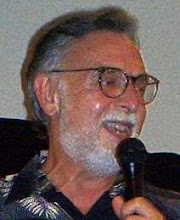The moment I laid eyes on the above photograph in a flea market stall I knew that I would be having a conversation with it for some time to come. A young woman survives the war and then, the embers of her city still glowing in the ruins, risks her life to walk a tightrope. The image jumped off the auction catalogue cover on which it appeared. It had been chosen from a collection of photographs being sold by a European auction house. When I picked up the catalogue sitting atop a stack of other magazines and looked into it, I was rather surprised to find that it bore no title or attribution; only the single word "ANONYM." I paid the vendor and left feeling that my purchase of the large, glossy version of the photo serving as the catalogue's cover was one of the best ten dollar bills I had ever spent. It is now framed and hanging in a place where I can look at it every day.
The photograph appears to have been taken amid the ruins of Berlin a short time after the Red Army had entered the city. I can only speculate. I might speculate even further that it was taken by the same photographer who took what I have always considered one of the most compelling photographs taken during World War II, Yevgeny Khaldei's image of a soldier raising the Red Flag over the conquered city. The two photos seem to share common artistic values, if not a common message.
I cannot be sure that Khaldei is ANONYM, but given the touchy relationship between Stalin and many Soviet artists, it would not be surprising if a Russian creator of an image bearing so open-ended a message as the woman on a tightrope at the end of the war might wish to remain anonymous. (When I googled to recall the Khaldei's name, I discoverd that Stalin's all-seeing eye noted that the soldier reaching up to the flag raiser was wearing a wrist watch on both of his wrists. Fearing that it would send out an impression of Red soldiers as looters, Stalin is said to have had the photograph doctored to eliminate one of the watches.) I find that as I get older, I am stripped of one romantic illusion after another. Following that tidbit found on the internet, I will never look at the image again without a certain twinge.
(http://www.dailymail.co.uk/news/article-564643/How-iconic-photo-Russians-raising-flag-burning-Berlin-airbrushed-save-soldier-Stalins-rage.html)
More of Khaldei's image later. Let us return to the lady on the tightrope. That the image may serve as a metaphor is obvious. Less obvious is precisely what it is that is metaphorically represented. A beautiful young woman--blonde, shapely, wearing a simple blouse and an apron over her tights--precariously ventures out over a world in ruins, a scattered crowd of observers looking up at her from the streets below. The ruins may be the remains of Berlin, but they could just as easily be the ruins of countless other cities throughout Europe devastated by aerial bombardment--a tactic used with equal enthusiasm and barbarism by both the Allies and the Axis forces. The woman--a kind of everyman and woman--having beaten the odds and survived the bombing--now tests fate partly out of an expression of her own free will, partly driven to do so to survive the peace, to put food on her kitchen table, clad in the very apron she wears on the high wire. Or is it rather that she is driven by the need to express her art, to...in spite of all that had occurred, to feel alive?
As it turned out, we would all be walking a tightrope in the aftermath of the second Great War of the twentieth century, the second "war to end all wars". In the final analysis, what had two world wars--costing over a 100 million lives--ultimately resolved? Even more fundamentally, why had those wars been fought? My thoughts turned to the events surrounding the demise of the Soviet Union in the closing decades of the twentieth century, less than fifty years after the end of the Great Patriotic War. On the front pages of the New York Times, R.W. Apple described the unfolding events as the most significant since the European revolutions of 1848. Alexander Solzhenitsyn's front page piece in the Times soon upped the ante; he was quoted as seeing the events as the most important since the French Revolution of 1789, which had taken place, amazingly, exactly 200 years before. From the Olympian heights of the farm in Vermont where he had taken refuge from his homeland, Solzhenitsyn went on to declaim that the revolutionary ideals of liberty, equality and fraternity had been proven to be irreconcilable.
Next: "The Line in the Sand"





No comments:
Post a Comment